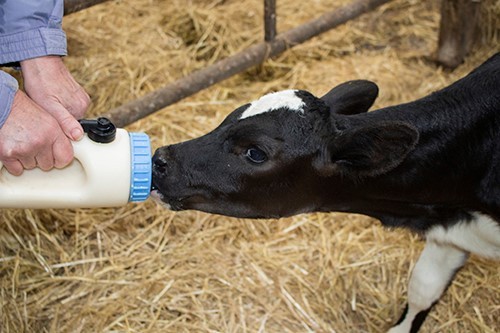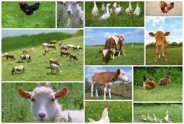Are you mastering your colostrum management?
Camila Lage, Dairy Management Specialist
Southwest New York Dairy, Livestock and Field Crops Program
The most important factor in determining the health and survival of a young calf is to achieve early and adequate intake of high-quality colostrum. When a calf is born, its gastrointestinal tract temporarily allows the absorption of large molecules including antibodies (immunoglobulins or IgG). This is called "passive transfer".
"Failure of passive transfer" (FPT) occurs when a calf fails to absorb an adequate quantity and quality of immunoglobulin. If we can deliver 150 to 200 g of IgG to the calf within 2-4 hours after birth, then less than 10% of calves should experience FPT. However, USDA's National Animal Health Monitoring System reported in 2014 that 13.5 percent of 1,005 Holstein heifer calves from the eastern half of the U.S. had FPT. Many herds have room to improve their calf welfare and performance by improving colostrum management.
Calves with a serum IgG of more than 10 g/L have successful passive transfer. Recently, a group of calf experts (Lombard et al., 2020) have shown that although mortality rates have decreased since 1991, the percentage of calves with at least one sick event during the pre-weaning period has not changed over the same time. In summary, calves with IgG serum of 10 g/L still get sick but are less likely to die.
With this new research, we now have new recommendations on herd-level passive immunity in dairy calves to help reduce morbidity (animals that get sick). The new recommendation is that herds attempt to reach the following targets to reduce both calf mortality AND calf morbidity:
Table 1. New recommendations for IgG (antibodies) concentrations and equivalent total protein (TP) and and percentage of calves recommended in each transfer of passive immunity (TPI) category

As we can see on the table above, instead of having all the animals with serum IgG concentrations ≥ 10 g/L, the important goal to keep in mind is: to have at least 40% of the animals with serum IgG concentrations ≥ 25.0 g/L and less than 10% of the animals with serum IgG lower than 10 g/L. To implement this new herd-level recommendation, producers should establish a routine to monitor enough calves to calculate the percentage of the herd in the various categories. If you are interested in understanding better how to do this, talk to your veterinarian or extension specialist for more information. While the recommendation is fairly new, the practices to mastering your colostrum management are still classic. According to Dr. Godden, from the University of Minnesota, a successful colostrum management program should follow the 5 Qs elements: Quality, Quantity, Quickness, sQueaky clean (cleanliness), and Quantifying (monitoring) the program results.
Quality
High-quality colostrum has an IgG concentration > 50 g/L. Colostrum quality can vary from dam to dam, and cow-side quality testing helps predict IgG concentration. The colostrometer estimates IgG concentration by measuring colostrum density). A more accurate tool, the Brix refractometer, measures sucrose concentration (Brix, %), which is positively correlated with IgG in colostrum. If less than 90% of cows are producing high-quality colostrum, we should review pre-fresh and just-fresh cow management. If you are interested in learning more about the techniques to measure colostrum quality, you can check out the links below:
Quantity
To provide 150-200 g of IgG to the calf, the colostrum volume fed will depend on quality. We help reach this goal by feeding a larger volume at first feeding (within the first 6 hours after birth). Experts currently recommend feeding 10% of birth weight (3-4 L) at the first feeding. However, if you struggle to meet this goal, or are aiming for higher IgG levels for your newborn calves, you should consider a second colostrum feeding (2-3 L before 8 hours after birth).
Quickly
A calf's ability to absorb antibodies across the gut is optimal in the first hours after birth and declines over time, with a complete closure by 24 hours after birth. As such, the optimal management strategy is aiming to feed all calves within 1-2 hours after birth, and by 6 as a maximum.
sQueaky clean
Good hygiene is essential when harvesting colostrum, either to give to a calf or store for later use. Fresh colostrum should be used within 2 hours of harvest or refrigerate or freeze stored colostrum ASAP. Refrigerated colostrum must be used within 48 hours. If frozen, it can be used within 6 months.
Quantify
Reviewing colostrum management on-farm is important to make sure calves are receiving the benefit of good quality colostrum. A colostrum protocol should evaluate colostrum quality and a calf's immune status. Talk to your veterinarian or contact your regional dairy extension specialist for more information about how to do it.
References
Godden, S. (2017) Management of the newborn calf. In: Large Dairy Herd Management (eds. David K. Beede and R.E. James), 399-408. Champaign - IL: American Dairy Science Association.
https://afs.ca.uky.edu/dairy/colostrum-management-dairy-calves, accessed on 9/7/2021
https://www.calfnotes.com/new/en/2020/06/10/calf-note-217-new-recommendations-on-passive-immunity-in-dairy-calves, accessed on 9/4/2021
Lombard, J., Urie, N., Garry, F., Godden, S., Quigley, J., Earleywine, T., McGuirk, S., Moore, D., Branan, M., Chamorro, M. and Smith, G., 2020. Consensus recommendations on calf-and herd-level passive immunity in dairy calves in the United States. Journal of dairy science, 103(8), pp.7611-7624.

https://hoards.com/article-18803-60-for-60-is-the-colostrum-sweet-spot.html, accessed 9/9/2021
Upcoming Events
Crops, Cows & Critters - Southwest New York Dairy, Livestock & Field Crops Newsletter Sponsorship
December 19, 2025
January 30, 2026
Our two forms of publications feature research-based and timely information from our four specialists, listed to the right, along with local event notifications and Cornell University outreach. This information is provided to participants who range from dairy, livestock, and field crops producers to agricultural suppliers and consultants.
Weekly Email Update: Shared with 625+ households who have signed up with our program.
Monthly Paper Mailer: To reach our stakeholders and farmers who lack internet access, we send out a monthly mailer where your company's logo and contact information would be featured with a mailing list of 330+ households.
If you sponsor our weekly and monthly publications you reach approximately 955 households.
Visit our website to view our newsletters!
2025 Cornell Food Beverage & Animal Feed Manufacturer Survey
December 19, 2025
Industry and Educational Advocates for New York State's Food, Beverage, and Animal Feed Manufacturing industries:
As you know, NYS has a diverse food and beverage manufacturing industry, in both the types of industries that exist and the wide distribution of firms by scale. Many manufacturing firms have strong backward linkages to agricultural production sectors in the state that support both farm-level and downstream food industry firms and consumers. In collaboration with the New York State Department of Agriculture and Markets, a team from Cornell University's Charles H. Dyson School of Applied Economics and Management has recently rolled out the 2025 New York State Food, Beverage, and Animal Feed Manufacturer Survey. The industry will benefit from an updated assessment of the industry that informs private and public investments and opportunities to support firm growth and improved profitability.
Boots in the Barn: Cornell Dairy Research Updates
January 13, 2026
January 20, 2026
January 27, 2026
February 3, 2026
February 10, 2026
February 17, 2026
February 24, 2026
Join us for some or all!
Announcements
No announcements at this time.





